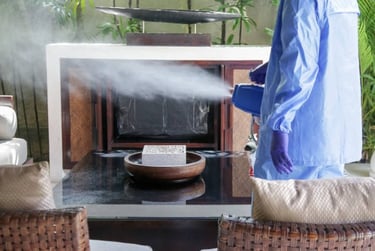Discover the impact of indoor air quality on health and the importance of sanitization.
Indoor Air Quality
Over the years, we have become astutely aware that numerous health problems are complicated by the Indoor Air Quality. What seems harmless to a healthy person is a nightmare for those suffering from immune deficiencies, allergies, asthma, and chronic illness.
While doctors may treat the patient, there is another process to reduce the aggravation of a health problem.
A toxic or semi-toxic house may only affect one or a few family members while others are unaffected. By neutralizing the ambient threats of toxins, allergens, or VOCs; we often discover an immediate feeling of relief for suffering family members.
Our non-toxic treatment neutralizes numerous aggravating threats in one treatment. To our surprise, we have seen marked improvement in the quality of life for those who us Better Blue to Sanitize and Neutralize the entire house.
We do not diagnose people or health conditions, but we can test a variety of issues concerning the toxic threats and Indoor Air Quality problems that irritate pre-existing health concerns. In many cases, the first treatment proves our point. Many experience, reduced symptoms, more energy, better sleep, easier breathing, and allergy relief.
We can assess your house or building in just one visit and provide a safe solution. We often see results in just one treatment. Our service is safe, affordable, and effective.




Our Mission Statement
Bad indoor air quality (IAQ) can pose significant health risks and have various negative impacts on both physical health and overall well-being. Some dangers associated with poor IAQ include:
Respiratory Problems: Exposure to indoor air pollutants such as dust, pollen, mold spores, pet dander, and volatile organic compounds (VOCs) can exacerbate respiratory conditions such as asthma, allergies, and chronic obstructive pulmonary disease (COPD). These pollutants can irritate the respiratory tract, trigger asthma attacks, and worsen existing respiratory symptoms.
Allergic Reactions: Indoor allergens such as dust mites, mold, and pet dander can cause allergic reactions in susceptible individuals, leading to symptoms such as sneezing, coughing, congestion, watery eyes, and skin rashes. Prolonged exposure to allergens can worsen allergy symptoms over time and decrease overall quality of life.
Increased Risk of Infections: Poor IAQ can contribute to the spread of infectious diseases by allowing pathogens such as bacteria and viruses to thrive indoors. Inadequate ventilation, high humidity levels, and contaminated surfaces can create environments conducive to the transmission of respiratory infections such as the flu, colds, and COVID-19.
Worsening of Existing Health Conditions: Individuals with pre-existing health conditions such as cardiovascular disease, respiratory disorders, and compromised immune systems may be more susceptible to the adverse effects of poor IAQ. Exposure to indoor air pollutants can exacerbate symptoms and increase the risk of complications in these vulnerable populations.
Headaches and Fatigue: Indoor air pollutants such as carbon monoxide, VOCs, and indoor particulate matter can cause non-specific symptoms such as headaches, dizziness, fatigue, and difficulty concentrating. Prolonged exposure to these pollutants can impair cognitive function and decrease productivity.
Long-Term Health Effects: Chronic exposure to indoor air pollutants has been linked to long-term health effects, including respiratory diseases, cardiovascular problems, neurological disorders, and certain cancers. These health effects may develop gradually over time and can have serious consequences for individuals' health and quality of life.
Poor Sleep Quality: Poor IAQ can disrupt sleep patterns and contribute to sleep disturbances such as insomnia and sleep apnea. Indoor air pollutants can trigger allergic reactions, respiratory symptoms, and discomfort, making it difficult for individuals to achieve restful sleep and wake up feeling refreshed.
Negative Impact on Mental Health: Indoor air quality can also affect mental health and well-being. Poor IAQ has been associated with increased stress, anxiety, and depression symptoms. Breathing clean air and maintaining a healthy indoor environment can help promote mental clarity, mood stability, and overall psychological well-being.
Overall, the dangers of bad indoor air quality highlight the importance of taking proactive measures to improve IAQ and create healthy indoor environments. Proper ventilation, regular cleaning and maintenance, use of air purifiers, and avoidance of indoor pollutants are essential steps for safeguarding occupants' health and well-being.









Sanitizing my indoor air has made a huge difference in my health and well-being.
Alice M.

I never realized how much indoor air quality affected my energy levels until I sanitized.
John D.

